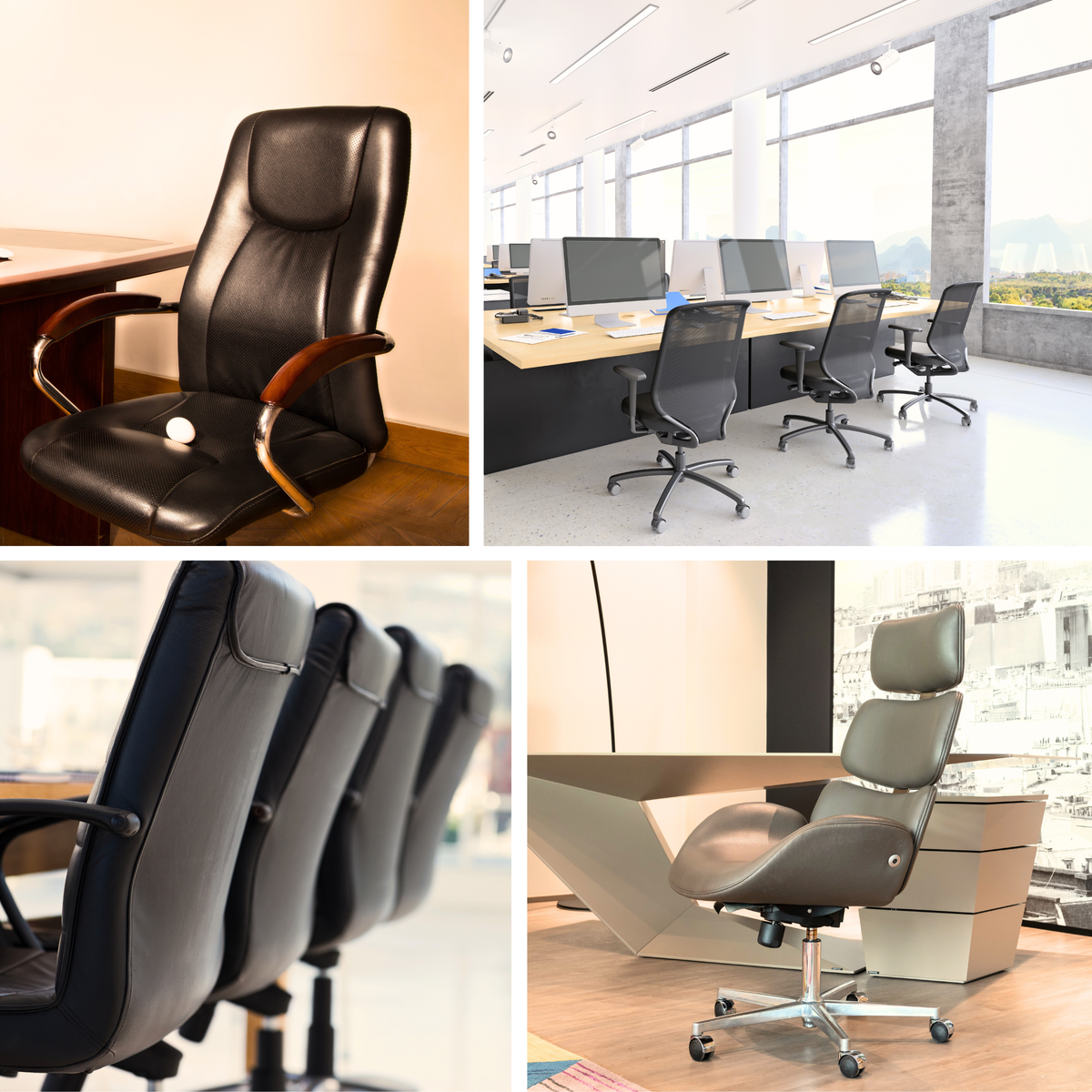Key Takeaways:
- Understanding the importance of ergonomic office chairs for health and productivity.
- Key features to look for when selecting the best ergonomic chair for your needs.
- How to properly adjust your ergonomic chair to fit your body for maximum comfort.
Ergonomic office chairs are not just a modern office trend; they are a crucial investment in your health and productivity. With the rise of the WFH setup, more people are realizing the importance of having a chair that not only looks good but also provides the necessary support for long hours of sitting. This comprehensive guide will delve into the world of ergonomic chairs, helping you understand why they are essential and how to choose the right one for your space and body.
What is Ergonomic Seating?
Ergonomic seating is designed to accommodate the human body's natural posture, reduce stress on the spine, and prevent the discomfort that comes from sitting for extended periods. The best office chair is one that can be adjusted to fit the unique contours of your body, ensuring that you maintain an upright and comfortable position throughout the day.
The Science Behind Ergonomic Chairs
Ergonomic chairs are the result of extensive research into human anatomy and the way we interact with our workspaces. They are crafted to provide optimal support to the areas of the body that are most prone to strain, such as the back, neck, and legs. By promoting good posture and movement, these chairs can help alleviate pain and enhance focus and efficiency.
Features of High-Quality Ergonomic Office Chairs
Adjustable Chairs: A Must-Have
The hallmark of an ergonomic chair is its adjustability. A chair that can be tailored to your body's needs is essential. Look for a seat height range that allows your feet to rest flat on the ground, with your knees at a 90-degree angle. Adjustable armrests are also crucial, as they can help reduce shoulder strain.
Lumbar Support: Your Back's Best Friend
Lumbar support is another critical feature of ergonomic office chairs. It ensures that your lower back, or lumbar region, is supported and maintains its natural curve. This support helps prevent slouching and reduces the risk of back pain.
The Branch Ergonomic Chair: A Case Study
The Branch Ergonomic Chair is a great option for those seeking a blend of style, comfort, and adjustability. With its sleek design, it fits seamlessly into any modern office or home space. The chair features a mesh back for breathability, a sturdy frame for durability, and multiple points of adjustability to ensure a perfect fit.
Ergonomic Chairs and Standing Desks: A Perfect Pair
Pairing an ergonomic chair with a standing desk can create the ultimate ergonomic workstation. Alternating between sitting and standing throughout the day can reduce the negative health impacts of prolonged sitting. An ergonomic chair ensures that when you do sit, you're supported correctly.
Seat Depth and Seat Cushion: Foundations of Comfort
Seat depth is an often-overlooked aspect of ergonomic chairs. The depth should allow you to sit with your back against the backrest while leaving space between the seat cushion and your knees. A quality seat cushion is also vital for comfort and can help distribute weight evenly to reduce pressure points.
Tilt Tension and Recline: Finding the Right Balance
Tilt tension and the ability to recline are features that allow you to lean back comfortably without feeling like you're toppling over. These adjustments can help you find the most comfortable position for your task at hand, whether you're typing away or taking a quick break to ponder.
The Importance of a Good Headrest
A headrest can make a significant difference in an ergonomic chair, especially for tall individuals or those with neck pain. It provides a place to rest your head and neck when reclining, reducing strain and supporting a natural posture.
Armrests and Their Role in Ergonomic Seating
Armrests are not just a place to rest your arms; they play a significant role in maintaining proper posture. They should be adjustable to match the height of your desk and allow your shoulders to remain relaxed while your arms are supported.
Choosing the Right Fabric for Your Ergonomic Chair
The fabric of your ergonomic chair should not be overlooked. It needs to be breathable to keep you cool, durable to withstand daily use, and comfortable against your skin. Mesh is a popular choice for its breathability and flexibility.
Ergonomic Office Chair Adjustments for Petite Users
When it comes to ergonomic office chairs, one size does not fit all, especially for those who are more petite. It's crucial that your feet rest flat on the ground to maintain proper posture and circulation. For individuals who find standard chairs too tall, chairs with adjustable seat heights are essential. Herman Miller, a leader in ergonomic design, offers chairs that cater to a wide range of body types, ensuring that even the most petite users can sit comfortably with their feet flat on the floor, avoiding the discomfort of dangling feet.
Moreover, many ergonomic chairs feature adjustable footrests, which can be a game-changer for shorter users. Footrests provide a stable platform for your feet, promoting better alignment and support throughout the day. When your feet are comfortably wrapped around a footrest, it reduces strain on your legs and lower back. This is particularly important for those who may not have their feet flat on the floor even with an adjustable chair. A task chair with this feature can make all the difference in creating a comfy, supportive workspace for every user, regardless of height.
The Role of Contact Points in Ergonomic Chair Comfort
The concept of contact points is central to ergonomic design. These are the areas where your body makes contact with the chair, such as the seat, backrest, and armrests. A high-quality ergonomic office chair will provide cushioned support that feels almost like a gentle, supportive hug. This 'wrapped' sensation ensures that pressure is evenly distributed across all contact points, reducing the risk of discomfort or pain. For instance, the featured lumbar support in many task chairs is designed to mimic the natural curve of your spine, offering targeted relief and promoting a healthier sitting posture.
In addition to lumbar support, the seat cushion plays a pivotal role in overall comfort. An ergonomic office chair should have a seat that's not too hard nor too soft, maintaining the delicate balance that supports long hours of work without causing fatigue. The seat should also be wide enough to accommodate different sitting positions while allowing you to maintain contact with the backrest. For those who spend a significant amount of time nurturing projects or cradling a baby in their arms while working, the comfort of these contact points becomes even more critical, making the choice of an ergonomic chair a vital decision for both well-being and productivity.
Ergonomic Chairs for Every Body Type
Ergonomic chairs are designed to accommodate most people, but it's essential to choose one that fits your specific body type. Whether you're petite or tall, there's an ergonomic chair that can be adjusted to provide the support you need.
The Role of Ergonomics in Health and Productivity
Investing in an ergonomic chair is investing in your health and productivity. Proper ergonomic support can reduce the risk of musculoskeletal disorders, increase comfort, and help you stay focused and efficient throughout the workday.
How to Adjust Your Ergonomic Chair
Properly adjusting your ergonomic chair is crucial for reaping its benefits. Start by setting the seat height so that your feet are flat on the ground and your thighs are parallel to the floor. Adjust the backrest, lumbar support, and armrests to fit your body snugly and comfortably.
The Impact of Ergonomic Chairs on Posture
Ergonomic chairs are designed to promote a natural, upright posture. By providing the right support, they encourage you to sit correctly, which can alleviate pain and prevent long-term health issues associated with poor posture.
The Aesthetics of Ergonomic Chairs: Style Meets Function
Ergonomic chairs can be both functional and stylish. Modern designs offer sleek lines and a variety of colors and materials to fit any office decor. You don't have to sacrifice style for comfort with today's ergonomic seating options.
Ergonomic Chairs and the Remote Work Revolution
With the rise of remote work, ergonomic chairs have become more important than ever. A comfortable, supportive chair is a cornerstone of a productive home office setup, helping you stay focused and comfortable throughout the workday.
The Long-Term Benefits of Investing in an Ergonomic Chair
While ergonomic chairs may come with a higher price tag, the long-term benefits they offer in terms of health and productivity make them a wise investment. A good chair can last for years, providing comfort and support every day.
Ergonomic Chairs: Not Just for Work
Ergonomic chairs are not only beneficial for the workplace. They can also enhance comfort and support for any activity that involves sitting, whether it's gaming, studying, or enjoying a hobby at home.
Finding the Right Ergonomic Chair for Your Space
When selecting an ergonomic chair, consider the space it will occupy. You'll want a chair that fits well in your office or house without overwhelming the area. Measure your space and look for a chair with a footprint that complements it.
The Future of Ergonomic Seating: Innovations and Trends
The field of ergonomic seating is constantly evolving, with new innovations and trends emerging regularly. From smart chairs that adjust automatically to your body to sustainable materials, the future of ergonomic chairs is exciting and promising.
Ergonomic Chairs and Environmental Sustainability
Many ergonomic chair manufacturers are now focusing on sustainability, using recycled materials and eco-friendly processes. Choosing a chair from a company that values the environment can help reduce your carbon footprint while still providing the ergonomic support you need.
The Best Ergonomic Chairs for Different Budgets
Ergonomic chairs come in a wide range of prices, from budget-friendly options to high-end models. Regardless of your budget, there is an ergonomic chair that can provide the features and support you need without breaking the bank.
How to Care for Your Ergonomic Chair
Proper maintenance can extend the life of your ergonomic chair. Regularly cleaning the fabric, checking the casters and moving parts for wear, and tightening any loose screws will help keep your chair in top condition.
The Role of Ergonomic Chairs in a Collaborative Workplace
In a collaborative workplace, ergonomic chairs can help create a comfortable environment that fosters teamwork and creativity. Chairs that are comfortable and adjustable allow team members to focus on collaboration rather than discomfort.
Summary
Ergonomic office chairs are essential for anyone who spends long hours sitting. They provide the necessary support to maintain good posture, reduce pain, and increase productivity. When choosing an ergonomic chair, consider adjustability, lumbar support, seat depth, and fabric, among other features. Properly adjusting your chair to fit your body is crucial for maximum benefit. Investing in an ergonomic chair is an investment in your health, comfort, and efficiency, whether for work or leisure.
FAQ Section
Q: How often should I stand up if I'm using an ergonomic chair?
A: It's recommended to stand up and move around for at least 5-10 minutes every hour, even if you're using an ergonomic chair. This helps to keep your blood circulating and muscles active.
Q: Can ergonomic chairs help with existing back pain?
A: Yes, ergonomic chairs can help alleviate existing back pain by providing proper support and encouraging good posture. However, it's important to consult with a healthcare professional for a personalized approach to managing back pain.
Q: Are ergonomic chairs worth the investment for freelancers or part-time workers?
A: Absolutely. Regardless of how many hours you work, an ergonomic chair can help prevent discomfort and health issues in the long run. It's a worthwhile investment for anyone who spends time sitting at a desk.










